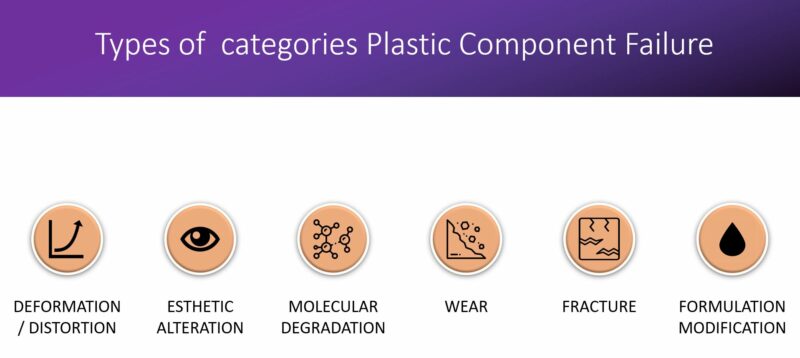If you know me, have heard one of my presentations, or read my papers, you know that I like to categorize things – put them into buckets. The same is true for the types of plastic component failure. I have identified what I believe are the six principal types of plastic failure. These include:
Deformation or Distortion: While in service, and under conditions of continuous stress or strain, dimensional changes can take place within a plastic component over time. This can occur through creep or stress relaxation. The change in dimension can result in improper fit or interference between mating components, resulting in failure.
Aesthetic Alteration: Although not often thought of as failure, the change of the appearance of a component, particularly one used by consumers, is a definite failure. For example, a piece of consumer electronics designed to have a branded bright white appearance that changes to a straw yellow coloration can be unacceptable.
Molecular Degradation: Molecular Degradation is the deleterious alteration of the molecular structure within a polymeric material as the result of a chemical reaction. Molecular degradation permanently alters the material and can result in the inability of a component, machine, or process to function properly, such that a component that can no longer perform its intended function safely.
Wear: Wear is the removal of material from or the impairment of a solid surface resulting from friction or impact. When surfaces slide over one another, they not only experience friction, they also wear. Material is lost from both surfaces, even when one is much harder than the other.
Fracture: This is the most commonly thought of mode of plastic failure. Cracking or fracture results when the stresses applied to the plastic component exceeded the strength of the material under the conditions of application. This can include such failure mechanism as overload, creep rupture, impact, fatigue, and environmental stress cracking.
Formulation Modification: This occurs when the composition of the plastic material is changed due to field service or exposure to other environmental conditions. For example, the absorption of water into nylon can significantly alter the properties of the material, rendering it unsuitable. Likewise, exposure to chemicals or solvents can result in additive abstraction again, significantly changing the composition and resulting material properties of the plastic.

